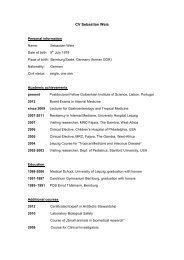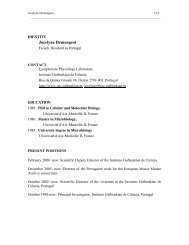organisation - the Instituto Gulbenkian de Ciência
organisation - the Instituto Gulbenkian de Ciência
organisation - the Instituto Gulbenkian de Ciência
- No tags were found...
Create successful ePaper yourself
Turn your PDF publications into a flip-book with our unique Google optimized e-Paper software.
We compared speed-accuracy tra<strong>de</strong>-offs (SATs) in odour <strong>de</strong>tection and categorisation<br />
and found large differences between tasks, <strong>de</strong>monstrating that SAT is<br />
problem-specific and suggesting that <strong>the</strong> locus of performance-limiting noise<br />
is a critical variable (manuscript in preparation). We <strong>de</strong>veloped a computational<br />
mo<strong>de</strong>l of <strong>the</strong>se tasks, which can be fit to <strong>the</strong> data, and which has allowed us to<br />
formalise <strong>the</strong>se hypo<strong>the</strong>ses.<br />
ACTION SELECTION AND ACTION TIMING IN THE PREMOTOR CORTEX<br />
Executing <strong>the</strong> right action at <strong>the</strong> right moment is important for adaptive behaviour.<br />
Thus, not only how we choose one action among multiple options but also<br />
how we <strong>de</strong>termine <strong>the</strong> timing of actions are fundamental questions.<br />
Our goal is to un<strong>de</strong>rstand what features of future actions are represented in<br />
<strong>the</strong> neuronal firing patterns in <strong>the</strong>se areas, and how <strong>the</strong> interaction between<br />
neurons gives rise to <strong>the</strong> action selection and action timing processes.<br />
To achieve this goal, we are using multiple single-unit recording techniques<br />
in behaving ro<strong>de</strong>nts. By correlating <strong>the</strong> activity of neurons with <strong>the</strong> animal’s<br />
behaviour, we are seeking to un<strong>de</strong>rstand <strong>the</strong> internal representation of future<br />
actions in <strong>the</strong> motor cortex. Fur<strong>the</strong>rmore, by analysing <strong>the</strong> relationships of<br />
spiking activity amongst multiple neurons, we hope to gain insight into computations<br />
within <strong>the</strong> microcircuits in <strong>the</strong> motor cortex. Finally, we will apply<br />
optogenetic techniques to perturb specific circuits and observe <strong>the</strong> impact on<br />
behaviour.<br />
We analysed neural correlates of action timing in <strong>the</strong> premotor cortex, documenting<br />
two classes of waiting-time predictive neurons and a dynamical systems<br />
analysis of <strong>the</strong> ensemble activity (manuscript submitted). We also <strong>de</strong>veloped a<br />
task in which we can manipulate <strong>the</strong> availability of potential action options. We<br />
began testing optogenetic interventions in <strong>the</strong>se contexts.<br />
EVALUATING THE RELIABILITY OF KNOWLEDGE:<br />
NEURAL MECHANISMS OF CONFIDENCE ESTIMATION<br />
Humans and o<strong>the</strong>r animals must often make <strong>de</strong>cisions on <strong>the</strong> basis of imperfect<br />
evi<strong>de</strong>nce. What is <strong>the</strong> neural basis for such judgments? How does <strong>the</strong> brain<br />
compute confi<strong>de</strong>nce estimates about predictions, memories and judgments?<br />
Previously, we found that a population of neurons in <strong>the</strong> orbitofrontal cortex<br />
(OFC) tracks <strong>the</strong> confi<strong>de</strong>nce in <strong>de</strong>cision outcomes. We are seeking to extend<br />
<strong>the</strong>se observations by testing whe<strong>the</strong>r confi<strong>de</strong>nce-related neural activity in <strong>the</strong><br />
OFC is causally related to confi<strong>de</strong>nce judgments. We are also addressing how<br />
<strong>the</strong> uncertainty about a stimulus in <strong>the</strong> course of <strong>de</strong>cision-making is computed<br />
in olfactory sensory cortex. We are currently establishing similar confi<strong>de</strong>ncereporting<br />
tasks in humans and testing <strong>the</strong>m in a range of behaviours. These<br />
experiments will give us fur<strong>the</strong>r insights into <strong>the</strong> nature of <strong>the</strong> neural processes<br />
un<strong>de</strong>rlying confi<strong>de</strong>nce estimation.<br />
In rats, we used chronic multi-electro<strong>de</strong> recordings to assay neural ensemble<br />
function in <strong>the</strong> olfactory tubercule of rats performing a confi<strong>de</strong>nce reporting<br />
task (study in progress). We also found that inactivation of <strong>the</strong> rat orbitofrontal<br />
cortex impairs confi<strong>de</strong>nce reporting but not choice behaviour (manuscript un<strong>de</strong>r<br />
review). In humans we tested confi<strong>de</strong>nce reporting tasks similar to those we<br />
<strong>de</strong>ployed in rats un<strong>de</strong>r several different psychophysical paradigms.<br />
IGC ANNUAL REPORT ‘11<br />
RESEARCH GROUPS<br />
48






